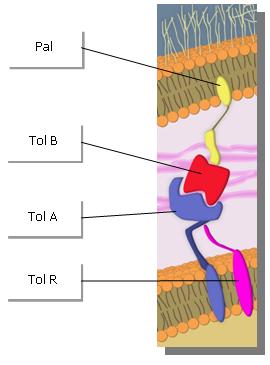Team:Paris/Production overview Tol/Pal
From 2009.igem.org
(→A. Tol/Pal) |
David.bikard (Talk | contribs) (→A. Tol/Pal) |
||
| Line 16: | Line 16: | ||
==A. Tol/Pal== | ==A. Tol/Pal== | ||
| - | + | <font color=yellow> Tu parles de plein de chose qui n'apportent rien à l'explication. Il faut juste donner les infos qui sont utiles pour comprendre ce qu'est Tol/Pal. De manière générale il faut aller directement à l'essentiel.</font> | |
The bacterial membrane consists of extracellular elements: proteins, polysaccharides, lipids. It is the membrane which gives to the bacteria its shape. There are two big types of bacteria, put in evidence by the Gram tint. (Gram + and gram-). | The bacterial membrane consists of extracellular elements: proteins, polysaccharides, lipids. It is the membrane which gives to the bacteria its shape. There are two big types of bacteria, put in evidence by the Gram tint. (Gram + and gram-). | ||
Revision as of 15:45, 18 October 2009
iGEM > Paris > Vesicle production system > Tol/Pal
A. Tol/Pal
Tu parles de plein de chose qui n'apportent rien à l'explication. Il faut juste donner les infos qui sont utiles pour comprendre ce qu'est Tol/Pal. De manière générale il faut aller directement à l'essentiel. The bacterial membrane consists of extracellular elements: proteins, polysaccharides, lipids. It is the membrane which gives to the bacteria its shape. There are two big types of bacteria, put in evidence by the Gram tint. (Gram + and gram-).
E. Coli is gram-. Its membrane is more complex. It includes two membranes: the inner membrane and the outer membrane. Between both, there is a layer of peptidoglycan.
The outer membrane presents lipo-polysaccharides (LPS). It plays role of barrier against antibiotics agents. They allow to pass nourishing elements, waste of the metabolism. We find porins and other carriers there. There are receivers for the entrance of nourishing elements, receivers in pili ( bacterial conjugation), receivers where settles bacteriophage. It has properties of selective permeability, protection and support. This complex of proteins is in place to maintain the stability between the inner membrane and the outer membrane.
In particular the system called Tol-Pal consisted of five proteins, TolA, TolB, TolQ, TolR and Pal[1][2]. This complex allows to maintain the integrity of the wall. Studies showed that if we destabilize this system, we also destabilize the membrane, leading then a production of vesicles. But when the membrane of the bacteria stays for such a long time in this state of destabilization, the bacteria produces too many vesicles and go in state of lysis.
What is Tol-Pal complex ?
The five proteins organised this complex[3]. The TolA/Q/R proteins form a protein complex in the inner membrane. TolB is a periplasmic protein associated with Pal, a lipoprotein. Pal is anchored to the outer membrane and interacts with the peptidoglycan layer. There are interactions with TolA–Pal and TolA–TolB.
References
- ^Transmembrane a-helix interactions are required for the functional assembly of the escherichia coli Tol complex. Lazzaroni & Geli 1995 - [http://www.pubmedcentral.nih.gov/articlerender.fcgi?artid=179564 179564]
- ^The Tol-Pal proteins of the Escherichia coli cell envelope an energized system required for outer membrane integrity. Lloubès & Journet 2001 - [http://www.ncbi.nlm.nih.gov/pubmed/11501670 11501670]
- ^Improved methods for producing outer membrane vesicles in gram-negative bacteria. Henry & Lloubès 2004 - [http://www.ncbi.nlm.nih.gov/pubmed/15249060 15249060]
 "
"
